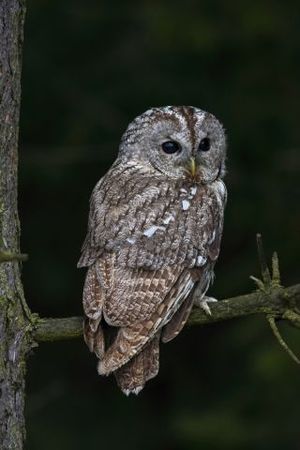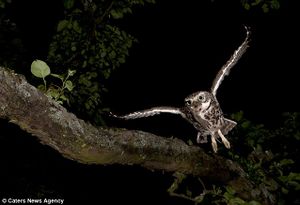Owl Evolution
Introduction
Owls are known for their unique ability to see in the dark. This allows them to hunt when most other predators are sleeping, giving them a unique advantage. Along with their nocturnal hunting ability, owls mate at night, and some owls have developed ways to communicate at night using light. For example, the male eagle owls have a white patch on their throat, which is presented to their desired mate during vocal displays and can reflect light from the surrounding area and be used to attract the female. The brighter the light coming from the patch of feathers on their chest, the more likely the female will be attracted to them. The eagle owl might be the first species to communicate nocturnally using light. This communication also plays a role in the natural selection of the eagle owl. It was found that eagle owls can spot intruders on their territory and defend their space, based on how bright the reflected light is from the invader's throat. The light was found to be a status signaling trait, so brighter reflecting patches were less likely to be attacked or defended against than eagle owls with less reflective patches. It was also found that brightness of reflectance was positively correlated with a higher breeding output. [1]


At right is a sample image insertion. It works for any image uploaded anywhere to MicrobeWiki. The insertion code consists of:
Double brackets: [[
Filename: PHIL_1181_lores.jpg
Thumbnail status: |thumb|
Pixel size: |300px|
Placement on page: |right|
Legend/credit: Electron micrograph of the Ebola Zaire virus. This was the first photo ever taken of the virus, on 10/13/1976. By Dr. F.A. Murphy, now at U.C. Davis, then at the CDC.
Closed double brackets: ]]
Other examples:
Bold
Italic
Subscript: H2O
Superscript: Fe3+
Section 1 Genetics
Owls are able to hunt at night based on sound alone. In order to do this, owls are born with the same basic wing structure as most birds, except the first primary feather on each wing is serrated, not smooth like in most birds. This allows the noise of the owl's flight to be silent. The serrated edges on the wings disrupt the sound of the air moving beneath and around them, so the owl is able to travel discretely. [2]
Along with silent flight, owls have adapted to rotate their necks up to 270 degrees. This ability allows for a owls to keep their eyes on their prey long after they would have left the field of vision of any competitor. In a study on neck rotation of the American barn owl, researchers used forced neck rotations of owl carcasses, along with virtual reconstructions of owl neck vertebrae to gather more information. They discovered that owls have 3 major sections in their neck: a horizontal lower part, an oblique middle part, and vertical upper part. These three parts form an S shape when the neck is relaxed.

Section 2 Microbiome
Birds are one of the main causes of pathogen spread across the world. This can be due to their worldwide flight, and their abilities to migrate and endure changing temperatures and habitats. Owls and other birds are able to carry bacteria that humans can also house, so it makes it easier for pathogens to be spread from one to the other, whether there is a third party involved or not.
Among other birds, owls carry bacteria that have been found to be resistant to antibiotic resistance..
Conclusion
Overall text length should be at least 1,000 words (before counting references), with at least 2 images. Include at least 5 references under Reference section.
References
Edited by [Jaidyn Cook], student of Joan Slonczewski for BIOL 116 Information in Living Systems, 2019, Kenyon College.
